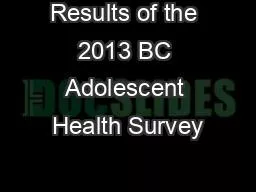

Sexual Health of Youth in BC 2013 BC Adolescent Health Survey 29832 surveys were completed 1645 classrooms 56 school districts 325 PHNs and nursing students Youth in British Columbia Diversity in ID: 785386
Download The PPT/PDF document "Results of the 2013 BC Adolescent Health..." is the property of its rightful owner. Permission is granted to download and print the materials on this web site for personal, non-commercial use only, and to display it on your personal computer provided you do not modify the materials and that you retain all copyright notices contained in the materials. By downloading content from our website, you accept the terms of this agreement.
Slide1
Results of the 2013 BC Adolescent Health Survey
Sexual Health of Youth in BC
Slide22013 BC Adolescent Health Survey
29,832 surveys were completed
1,645 classrooms
56 school districts325 PHN’s and nursing students
Slide3Youth in British Columbia
Diversity in
sexual orientation and gender identity
ethnic and cultural backgroundwhere youth lived
Slide4Sexual Activity
Slide5No sexual activity
75% of male and female youth had not had oral sex or intercourse
Younger youth were more likely to have not been sexually active.
Slide6Youth were less likely to have been sexually active if they:
Were connected to family and school
Had
a
supportive adult inside the family
Felt good about themselves and their abilities
Note: Sexual activity refers to oral sex and/or intercourse.
Slide7Oral sex
23% had ever had oral sex (26% in 2008)
Slide8Intercourse
(sex other than oral sex or masturbation)
Slide9Sexual Health & Risk Behaviours
Slide10First Intercourse, Partners, and Substance Use
Slide11Age at first intercourse
Slide12Safer sexual health practices
among older youth
Sexual health
and age of sexual debut
(among youth aged 16 to 19 who ever had intercourse)
First had intercourse at age 14 or younger
First
had intercourse at age 15 or older
Condom or other barrier used the last time had intercourse
59%
72%
Effective
contraception used the last time had intercourse
80%
90%
Note: Effective contraception refers to the use of condoms, birth control pills,
Depo
Provera
, or another doctor-prescribed method (e.g., IUDs, birth control patch, birth control ring).
Slide13Number of sexual partners
53% of youth who ever had intercourse had one sexual partner in the past year
20% had three or more partners in the past year
Slide14Gender of sexual partners
Slide15Substance use and sexual activity
Note: The difference for males between 2003 and 2008 was not statistically significant.
Slide16STIs and Pregnancy
Slide17Efforts to prevent STIs
17% of youth who ever had oral sex used a condom or other barrier the last time they had oral sex
69% of youth who ever had intercourse used a condom or other barrier the last time they had intercourse
Slide18STIs
Slide19Efforts to prevent pregnancy
Efforts made by youth or
their partner to prevent pregnancy the last time they had sex (among those who ever had intercourse)
Males
Females
Condoms
69%
61%
Birth control pills
45%
51%
Withdrawal
33%
38%
Depo
Provera
1%
3%
Not sure
4%
2%
Note: Youth could choose more than one response.
Slide20Pregnancy
Slide21Dual method use
35% were dual method users the last time they had intercourse
35% used a condom or other barrier exclusively
17% used a hormonal contraceptive or IUD exclusively
14% used neither a barrier nor hormonal contraceptive or IUD
Slide22Trends
Slide23Improvements in sexual health
34% first had intercourse before the age of 15
3% used no contraception the last time had intercourse
69% used a condom the last time they had intercourse
24% used drugs or alcohol last time they had intercourse
5% had ever been pregnant or caused a pregnancy
3% ever had an STI
Among those who had ever had intercourse:
Slide24Regional Comparisons
Slide25Risk and Protective Factors
Slide26Risks to sexual health
Living situation
Home environment
Social environmentMarginalizationViolence exposure
Slide27Food insecurity/Poverty
Slide28Being a refugee
* Interpret with caution as the standard of error was relatively high but still within an acceptable range.
Slide29Reducing inequities in sexual health
Students who were:
Connected to family and school
Had supportive adult and peer networksWere engaged in extracurricular activities
Had aspirations for the future all reported healthier sexual health practices.
Slide30Supportive adult
Slide31Vulnerable groups
Note: Effective contraception refers to the use of condoms, birth control pills,
Depo
Provera
, or another doctor-prescribed method (e.g., IUDs, birth control patch, birth control ring).
Slide32Youth’s Suggestions for Improving Sexual Health
Slide33Youth’s suggestions for improving sexual health
“You guys can’t keep teaching abstinence only sex ed. You need to teach about different kinds of birth control and condoms. So many people do stupid stuff because they didn’t know another way existed.”
“I think there needs to be more of the youth clinics around and they should be open more hours (for example, the one near my school is only open 3 days a week, 3-4 hours at a time.”
Slide34Concluding remarks
Youth are engaging in safer sexual health practices, and trends indicate improvements in this area.
Identified groups of young people who may be experiencing sexual health risks or inequities.
Suggested areas where young people may need more support and the protective factors that might contribute to healthy sexual development.
Slide35Resources
Slide36Sexual health posters for youth
Slide37Grants up to $500 for youth-led projects
Slide38Thank you
mccreary@mcs.bc.ca
604-291-1996